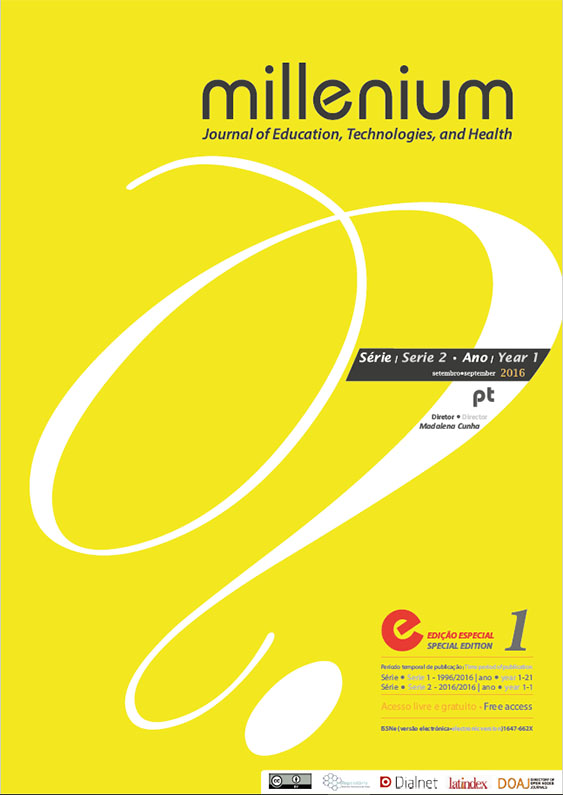Fall Risk Prevalence and Determinants in Elderly Institutionalized
Keywords:
Elderly, Risk of falls, Institutionalization, Functional ability, BalanceAbstract
Introduction: The institutionalized elderly are at increased risk of falling compared to the non-institutionalized elderly . The issue of falls should be seen as a serious public health problem , given its consequences and irreversible costs.
Objective: The study aims to assess the risk and determinants of falls in institutionalized elderly .
Methods: non-experimental , cross-sectional, descriptive and correlational and quantitative study . Used a non-probabilistic convenience sample consisting of 136 institutionalized elderly with ages ranging between 65 and 99 years old with an average age of 85.98 years .. The data collection was used a protocol that integrated issues of socio-demographic characterization , and clinical context . They also used the scales of Family Functioning, Addiction Rating Scale in the Self-care and Tinetti Scale ( POMA I) .
Results: The majority of the sample has downside risk, since about 45.6% of the elderly has a high risk of falling, 16.2% and 38.2% medium risk low risk. We have further found that the risk of loss was higher in the elderly: female gender (p = 0.014) with low literacy (p = 0.000), with cognitive impairment (p = 0.014), neurological disorders and osteoarticular (p = 0.000) and with reduced eyesight and hearing. (P = 0.010).
Conclusions: Conversely, more autonomous elderly gait, personal hygiene and medication taken were those with lower risk of falling.
Downloads
References
Almeida, P., & Neves, R. (2013). As quedas e o medo de cair em pessoas idosas institucionalizadas. Revista Kairós Gerontologia, 15(5), 27-43.
Almeida, C. (2012). Risco de quedas nas UCCI do distrito de Viseu: Estudo comparativo escala de Morse e escala de Dowton (Dissertação de Mestrado, Instituto Politécnico de Viseu, Portugal). Acedido em http://repositorio.ipv.pt/handle/10400.19/1732
Barbosa, A., & Oliveira, C. (2012). Prevalência de quedas, fatores de risco e nível de atividade física em idosos institucionalizados. Revista Brasileira de Ciências do Envelhecimento Humano, 9(1), 57-70.
Contreiras, T., Rodrigues, E., & Nunes, B. (2011). Acidentes domésticos e de lazer: Informação adequada: Relatório 2006-2008. Lisboa: INSA.
Carvalho, P., & Dias, O. (2011). Adaptação dos idosos institucionalizados. Millenium, 40, 161-184.
Drago, S., & Martins, R. (2012). A depressão no idoso. Millenium, 43, 70-94.
Freitas, E. V., & Py, L. (2011). Tratado de geriatria e gerontologia (3ªed.). Rio de Janeiro: Guanabara Koogan.
Ferreira, D., & Yoshitome, A. (2010). Prevalência de quedas de idosos institucionalizados. Revista Brasileira de Enfermagem, 63(6), 991-7.
Gomes, E., Marques, A., Leal, M., & Barros, B. (2014). Fatores associados ao risco de queda em idosos institucionalizados: Uma revisão integrativa. Ciências & Saúde Coletiva, 19(8), 3543-3551.
Gonçalves, D., Altermann, C., Vieira, A., Machado, A. P., Fernandes, R., Oliveira, A., & Mello-Carpes, P. B. (2014). Avaliação das funções cognitivas, qualidade de sono, tempo de reação e risco de queda em idosos institucionalizados. Estudos Interdisciplinares do Envelhecimento, 19(1), 95-108. Acedido em http://www.seer.ufrgs.br/index.php/RevEnvelhecer/article/view/26009/31003
Lord, S.R., Sherrinton, C., Menz, H.B., & Close J.C.T. (2007). Falls in older people: Risk factors and strategies for prevention (2ªed.).Cambridge: Cambridge University Press.
Paraíso, R. (2014). Fatores de risco de queda em idosos institucionalizados (Dissertação de mestrado, Universidade Nova de Lisboa, Portugal). Acedido em https://run.unl.pt/bitstream/10362/14227/1/Paraiso,%20Rita%20TM%202014.pdf
Peres, M. O. (2014). Os idosos institucionalizados: Estudo de algumas variáveis (Dissertação de mestrado, Instituto Politécnico de Bragança, Portugal). Acedido em http://repositorio.ipcb.pt/handle/10400.11/2707
Portugal, Instituto Nacional de Estatística. (2014). Estatísticas demográficas 2013. Lisboa: INE, IP.
Portugal , Instituto Nacional de Estatística. (2015). As pessoas 2013. Lisboa: INE, IP.
Ribeiro, O., & Paul, C. (2011). Manual de envelhecimento ativo. Porto: Lidel.
Santos, A. M. M. (2012). Quedas em idosos institucionalizados (Dissertação de mestrado, Universidade da Beira Interior, Portugal). Acedido em http://ubibliorum.ubi.pt/handle/10400.6/1211
Silva, J. V. (2009). Processo de envelhecimento sobre múltiplos aspetos. São Paulo: Látria.
Silva, J., Camargo, R., Nunes, M., Camargo, T., Faria, C., & Abreu, L. (2014). Análise da alteração do equilíbrio, da marcha e o risco de queda em idosos participantes de um programa de fisioterapia. Revista E-Ciência, 2(2), 19-23.
Teixeira, C., Schmidt, F., Muraro, M., Meereis, E., & Gonçalves, M. (2014). Prevalência do risco de quedas em idosos de uma instituição de longa permanência de Santa Maria. Revista Kairós Gerontologia, 17(1), 46-56.
World Health Organization. (2007). WHO global report on falls prevention in older age. Genève: WHO Press.
Downloads
How to Cite
Issue
Section
License
Authors who submit proposals for this journal agree to the following terms:
a) Articles are published under the Licença Creative Commons (CC BY 4.0), in full open-access, without any cost or fees of any kind to the author or the reader;
b) The authors retain copyright and grant the journal right of first publication, allowing the free sharing of work, provided it is correctly attributed the authorship and initial publication in this journal;
c) The authors are permitted to take on additional contracts separately for non-exclusive distribution of the version of the work published in this journal (eg, post it to an institutional repository or as a book), with an acknowledgment of its initial publication in this journal;
d) Authors are permitted and encouraged to publish and distribute their work online (eg, in institutional repositories or on their website) as it can lead to productive exchanges, as well as increase the impact and citation of published work
Documents required for submission
Article template (Editable format)















